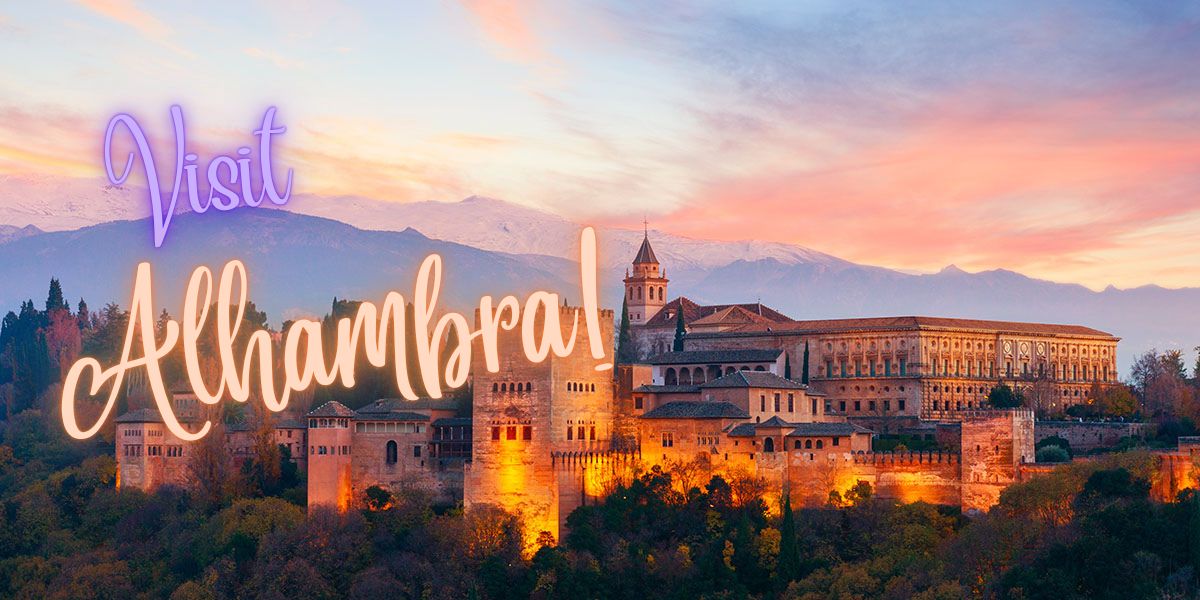The Alhambra, Granada’s Lush, Lavish and Last Great Palace

History calls it The Dark Ages. The earth is flat. Ships sailing across the ocean intent on returning with the fabled riches of India may perish in the void. Darkness has descended as a global cold front sweeps across Europe. In the ensuing misery of famine and disease, barbarians fan out across the continent intent on conquest. This is the world of Alhambra in 1238.

In Granada, on the Iberian Peninsula, Moorish magnificence flourishes with Alhambra as its signature. Unrivaled on the continent for its intricate, jaw-dropping beauty.
And that’s enough reason to visit. But the backstory enhanced my appreciation of Alhambra.
One of the last Moorish strongholds in Europe, Granada stands in a singular position as a symbol of retreat.
The History of Alhambra
The history of the Alhambra is linked to Granada. On the banks of the river Darro, protected by the mountains and surrounded by forest, among the oldest districts of the city, the Alhambra rises like an imposing castle of reddish tones and walls that hide the delicate beauty of its interior.

It was built on the Sabika hill, an outcrop of the Sierra Nevada which had been the site of earlier fortresses. Building began in 1238 under the first Nasrid Emir and founder of the Emirate of Granada, the last Muslim state in the area now known as Andalusia. Later rulers modified the complex and the most significant construction took place in the 14th century, over 700 years ago.
Alhambra became the royal residence and court of Granada in the mid-13th century after the establishment of the Nasrid Kingdom and the construction of the first palace by the founding king Mohammed ibn Yusuf Ben Nasr, better known as Alhamar.

As a royal city and citadel, it contained at least six major palaces. The most famous and best-preserved are the Mexuar, the Comares Palace, the Palace of the Lions, and the Partal Palace, which form the main attraction for visitors today. Outside the Alhambra walls and located nearby to the east is the Generalife. These gardens, bountiful orchards and landscaping, formerly a Nasrid summer palace, are fully restored and part of the Alhambra tour.


Incomparable Beauty
Ornate stucco, blinding, brilliant colors, scalloped windows showcasing views of lush, elaborate gardens made so with an abundance of fountains like no other place on earth. Water. The rarest and most precious element in the Islamic world was a symbol of life and purity.

Water, still and pooling, spouting from fountains, cascading over walls, used as a backdrop for conversation. It’s everywhere and remains lavishly used as decoration even today.
The interior walls are carved with lyrics written by court poets, phrases from sacred Islamic texts, complex geometric patterns, beautiful even after over 800 years. Its architecture marvels the visitor with its sophistication.



The Red Castle
The name Alhambra has its origins in an Arabic word meaning “red castle or vermilion”, perhaps due to the color tone of the towers and walls that completely surround the hill of La Sabica. In the starlight it is silver but in the light of the sun Alhambra acquires a reddish-golden tone.


Ferdinand and Isabella
In 1492, Alhambra became the Royal Court of King Ferdinand and Queen Isabella and it was here that Christopher Columbus received royal endorsement for the expedition leading to his discovery of the Americas. Another astonishing fact concerns its surrender.

The Holy Wars
During the Reconquista, Christian rulers waged war on the Muslim dynasties all across the area now known as Spain and Portugal. 1492 stands out for reasons other than Columbus’s expedition. In 1491 the monarchs launched a successful assault on Granada. On the night of January 2, 1492, considering his imminent defeat, the last Nasrid Emir Muhammad XII invited the invading Christian Castilian forces inside of Alhambra. Rather than risk its destruction and the murder of his people, he handed over the keys without a fight.

Fifty years later Charles V commissioned a new Renaissance-style palace, awkwardly incorporating the main structure but it was incomplete for two centuries. Today it still looks out of place and in disharmony with the main palace buildings.
In disrepair for another couple of hundred years and occupied by squatters, Alhambra was rediscovered by the British followed by American and northern European travelers, notably American novelist Washington Irving, one of the great American storytellers, (Rip Van WInkle, The Legend of Sleepy Hollow). Touring Spain in 1828, Irving spent time in Alhambra penning the book titled Tales from the Alhambra whose fame is credited with renewing interest in the city of Granada and it’s architectural treasure.
A palace like no other and worth a visit!
Click here for information on ticket purchase options, hours of operation and location.
Related Posts
Rio de Janeiro and the Girl from Ipanema: Where Music Meets the Sea
Rio de Janeiro is more than a city—it’s sun-soaked poetry. From the iconic Christ the …
May 3, 2025Visit the Most Beautiful Bookstore in the World
It’s called El Ateneo, Spanish for “The Athenaeum”, a place associated with learning, the arts …
April 26, 2025

Leave A Comment